April 6
Transcription of the old articles added, scroll to the bottom.
April 2
Speaking of great fires in the city’s history, did you know that the original State Capitol was destroyed by fire? The building was called the State House and it burned one morning in June 1831.
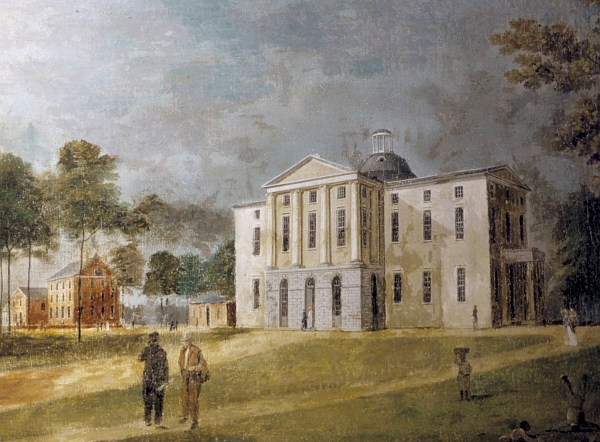
Jacob Marling painting, 1818
Awful Conflagration!
June 21, 1831. Tuesday morning. About 7:00 a.m.
The State House was ablaze on Union Square.
Raleigh’s citizens were summoned to the scene to help fight the fire. But all attempts to extinguish the blaze proved pointless–they had only the simplest of equipment: buckets, wells, and one hand-operated fire engine–and bystanders were instead directed to protect the other public and privates on the square. They also assisted with saving the official archives.
No other buildings were damaged, and the spread of the flames may have been retarded by the large oak trees that surrounded the State House, speculated newspaper editor Joseph Gales.
Most of the public records were saved, along with some furniture, and a painting of George Washington that still hangs in the Capitol today. Lost in the blaze, however, was a marble statue of Washington by Italian sculptor Antonia Canova, considered one of the masterpieces of the world. Or so said the stories of the time. (Mr. Blogger isn’t an art historian, nor plays one on television.)
The fire was believed to have started during the installation of a new fireproof roof, by the careless actions of a construction working while soldering the zinc material.
This fire and a series of other destructive fires in the 1830s had one positive effect: city, county, and state governments began building using more fire-resistant materials. Stone and brick were used in the 1837 County Courthouse, the 1840 City Hall, and the 1840 State Capitol. Several business on Fayetteville Street, that lost their buildings in an 1833 fire, also rebuilt with brick.
Raleigh Register, June 1831
Two days after the fire, this account appeared in the weekly newspaper The Raleigh Register. Then a second story, with more details, was published the week after.
Scroll down for a transcript.
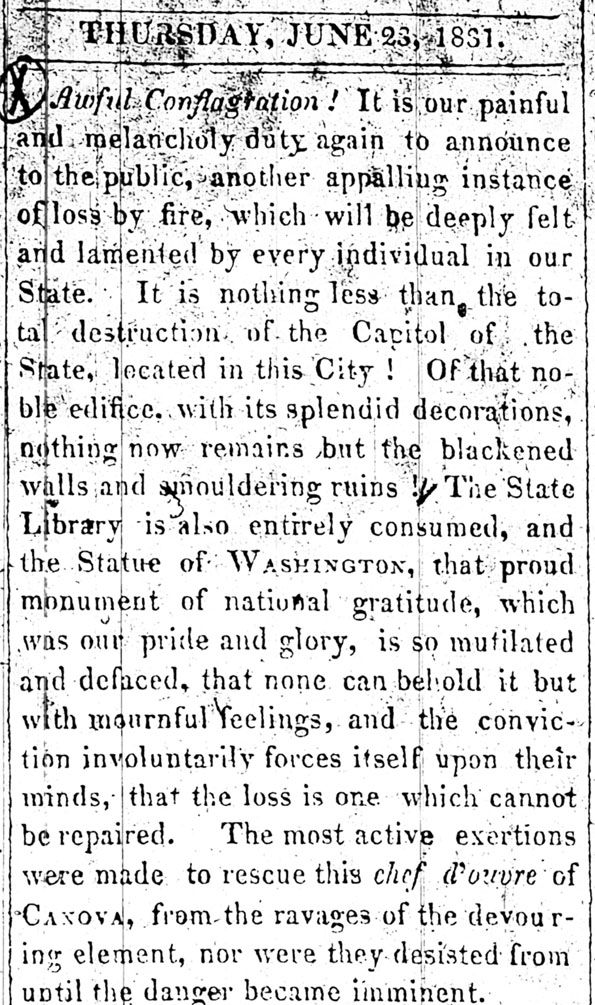
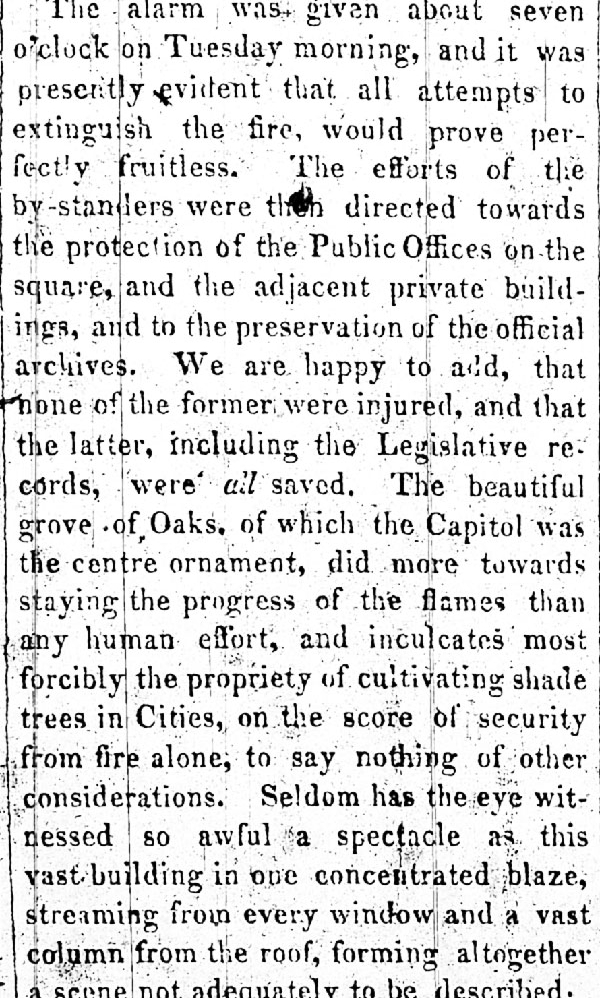
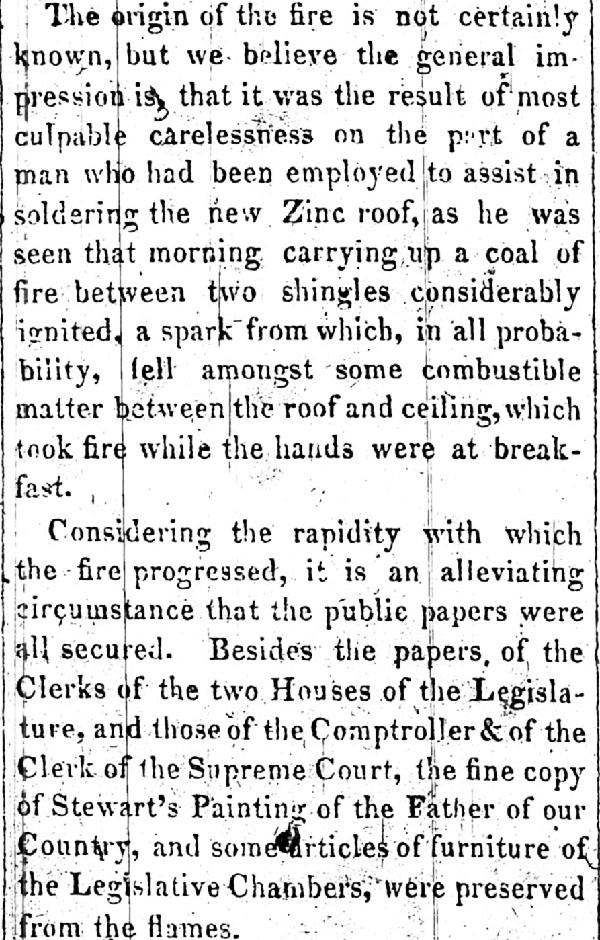
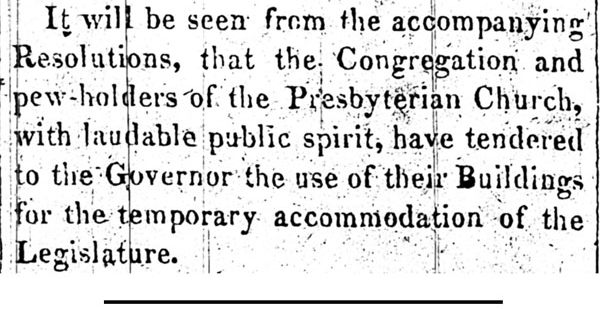
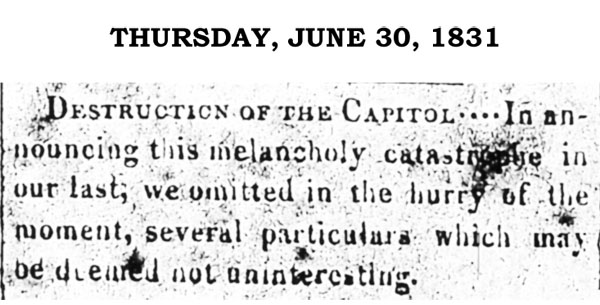
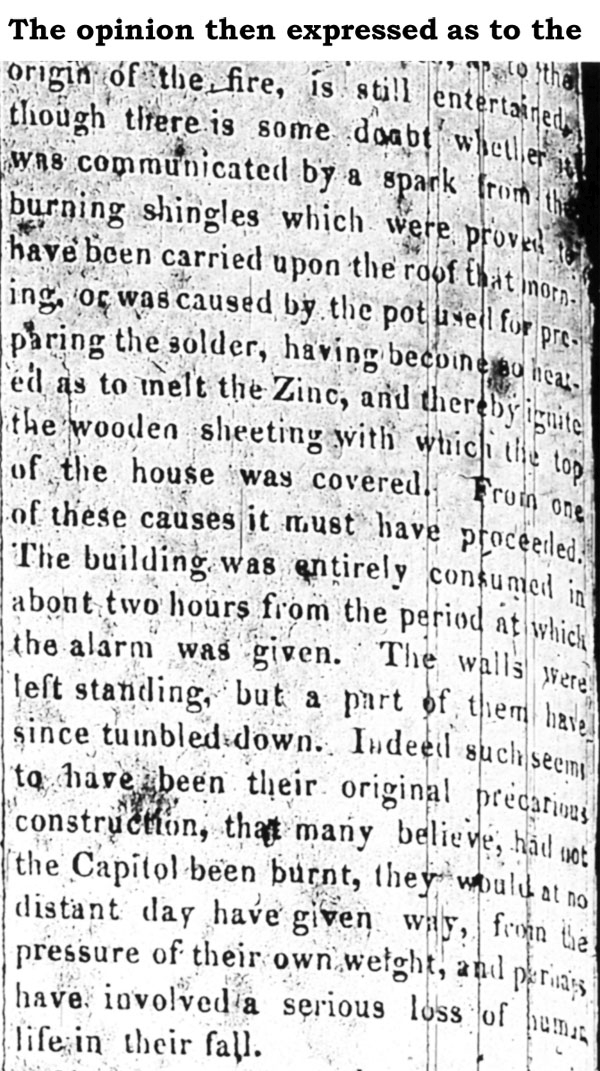
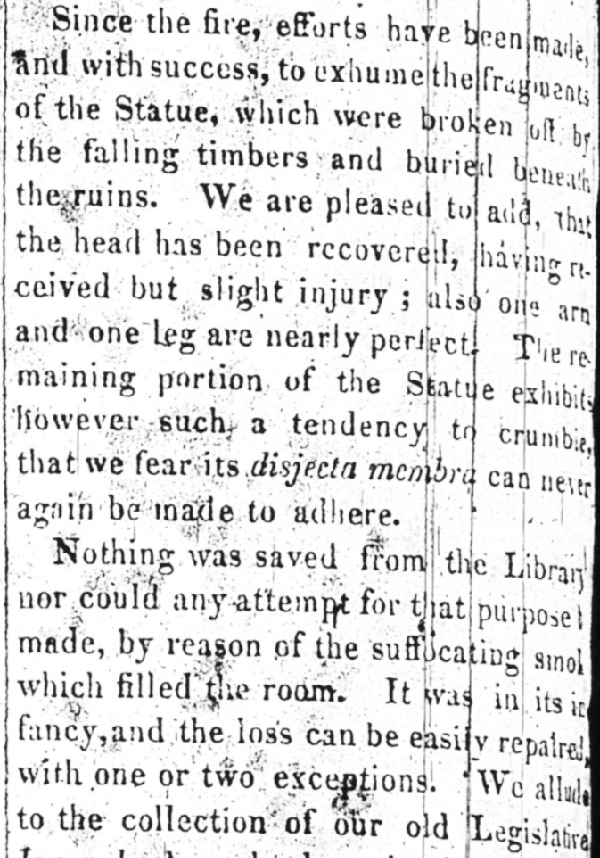
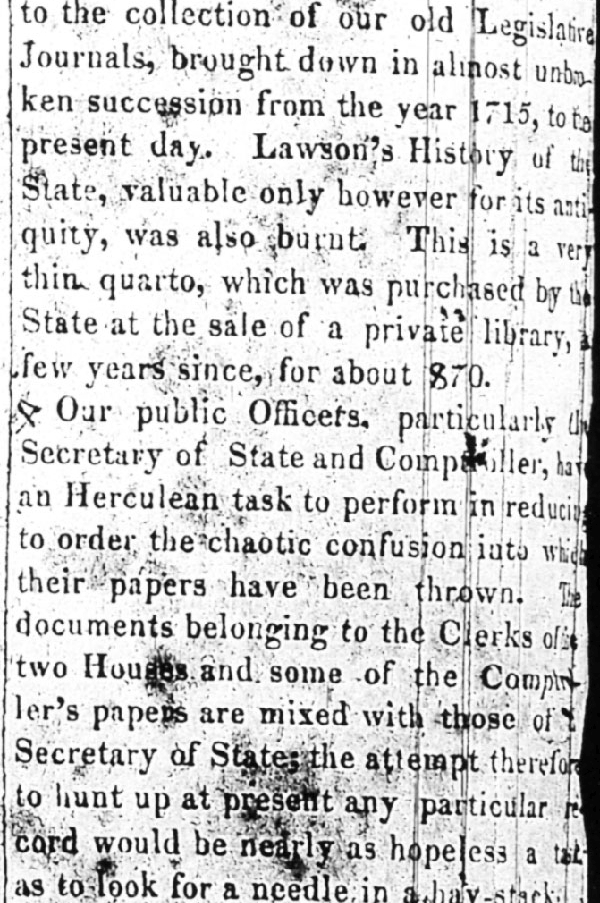
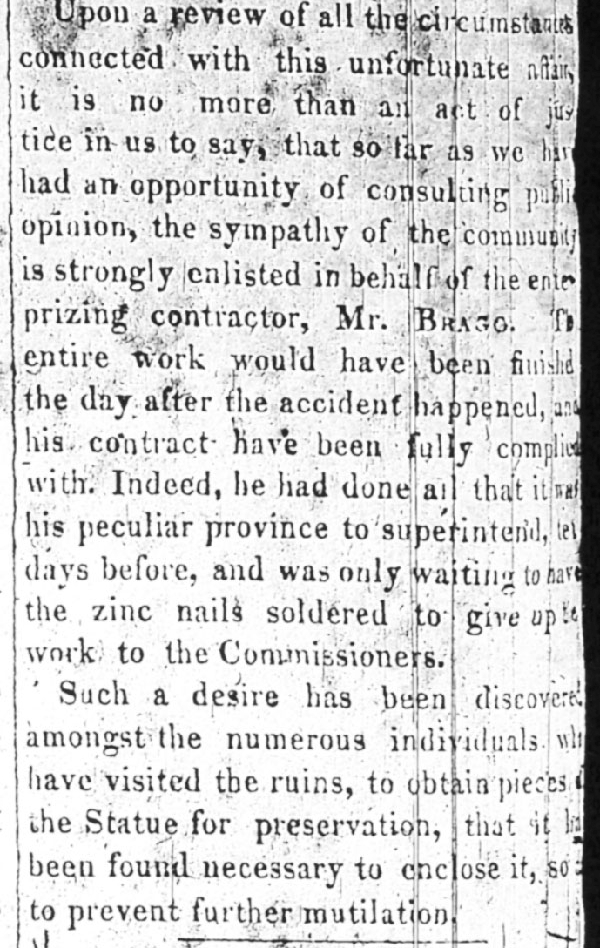
Transcription
Thursday, June 23, 1831
Awful Conflagration! It is our painful and melancholy duty again to announce to the public, another appalling instance of loss by fire, which will be deeply felt and lamented by everything individual in our State. It is nothing less than the total destruction of the Capitol of the State, located in this City! Of that notable edifice, with its splendid decorations, nothing now remains, but the blackened walls and smouldering ruins. The State Library is also entirely consumed, and the Statue of Washington, that proud monument of national gratitude, which was our pride and glory, is so mutilated and defaced, that none can behold it but with mournful feelings, and the conviction involuntarily forces itself upon their minds, that the loss is one which cannot be repaired. The most active exertions were made to rescue this chef d’ouvre, of Canova, from the ravages of the devouring element, nor were they desisted from until the danger became imminent.
The alarm was given about seven o’clock on Tuesday morning, and it was presently evident that all attempts to extinguish the fire, would provide perfectly fruitless. The efforts of the by-standers were then directed towards the protection of the Public Offices on the square, and the adjacent private buildings, and to the preservation of the official archives. We are happy to add, that none of the former were injured, and that the latter, including the Legislative records, were all saved. The beautiful grove of Oaks, of which the Capitol was the centre ornament, did more towards staying the progress of the flames than any human effort, and inculcates most forcibly the propriety of cultivating shade trees in Cities, on the score of security from fire alone, to say nothing of other considerations. Seldom has the eye witnessed so awful a spectacle as the vast building in one concentrated blaze, streaming from every window and a vast column from the roof, forming together a scene not adequately to be described.
The origin of the fire is not certainly known, but we believe the general impression is that it was the result of most culpable carelessness on the part of a man who had been employed to assist in soldering a new Zinc roof, as he was seen that morning carrying up a coal of fire between two shingles considerably ignited, a spark from which, in all probability, fell amongst some combustible matter between roof and ceiling, which took fire while the hands were at breakfast.
Considering the rapidity with which the fire progressed, it is an alleviating circumstance that the public papers were all secured. Beside the papers of the Clerks of the two Houses of the Legislature, and those of the Comptroller & of the Clerk of Supreme Court, the fine copy of Stewart’s Painting of the Father of our Country, and some articles of furniture of the Legislative Chambers, were preserved from the flames.
It will be seen from the accompanying Resolutions, that the Congregation and pew-holders of the Presbyterian Church, with laudable public spirit, have tendered to the Governor the use of their Buildings for the temporary accommodation of the legislature.
Thursday, June 30, 1831
Destruction of the Capitol
In announcing this melancholy catastrophe in our last, we omitted in the hurry of the moment, several particulars which may be deemed not uninteresting.
The opinion then expressed as to the origin of the fire, is still entertained, though there is some doubt whether it was communicated by a spark from the burning shingles which were proved to have been carried upon the roof that morning, or was caused by the pot used for preparing the solder, having become so heated as to melt the Zinc, and thereby igniting the wooden sheeting with which the top of the house was covered. From one of these causes it must have proceeded. The building was entirely consumed in about two hours from the period at which the alarm was given. The walls were left standing, but a part of them have since tumbled down. Indeed such seems to have been their original precarious construction, that many believe, had not the Capitol been burnt, they would at no distant day have given way, from the pressure of their own eight, and perhaps have involved a serious loss of human life in their fall.
Since the fire, efforts have been made, and with success, to exhume the fragments of the Statute, which were broken off by the falling timbers and buried beneath the ruins. We are pleased to add, that the head has been recovered, having received but slight injury; also one arm and one leg are nearly perfect. The remaining portion of the Statue exhibits however such a tendency to crumble, that we fear its disjecta membra can never be made to adhere.
Nothing was saved from the Library no could any attempt for that purpose made, for reason of the suffocating smoke which filled the room. It was in its infancy, and the loss can be easily repaired, with one or two exceptions. We allude to the collection of our old Legislature Journals, brought down in almost unbroken succession from the year 1715, to present day. Lawson’s History of the State, valuable only for its antiquity, was also burnt. This is a very thin quarto, which was purchased by the State at the sale of a private library, a few years since, for about $70.
Our public Officers, particularly the Secretary of State and Comptroller, have an Herculean task to perform in reducing to order the chaotic confusion into which their papers have been thrown. The documents belonging to the Clerks of the two Houses and some of the Comptroller’s papers are mixed with those of the Secretary of State; the attempt therefore to hunt up at present any particular record would be nearly as hopeless a task as to look for a needle in a hay-stack.
Upon a review of all the circumstances connected with this unfortunate affair, it is no more than an act of justice in us to say, that so far as we have had an opportunity of consulting public opinion, the sympathy of the community is strongly enlisted in behalf of the enterprizing contractor, Mr. Bragg. The entire work would have been finished the day after the accident happened, and his contract would have been fully completed with. Indeed, he had done all that it was his particular province to superintend, ten [?] days before, and was only waiting to have the zinc nails soldered to give up the work to the Commissioners.
Such a desire has been discovered, amongst the numerous individuals, who have visited the ruins, to obtain pieces of the Statue for preservation, that it has been found necessary to enclose it, so to prevent further mutilation.